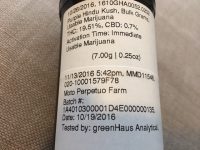The culture of the cannabis industry is filled with passion that many envy, and for valid reasons. The roots of the cannabis plant go back thousands of years. As of this writing, there are no documented human deaths that were caused by a phytocannabinoid overdose. However, it is not all rainbows and unicorns.
Before breaking ground, fundraising, proper facility design, competitive application and permitting requirements are just the start. Once operating, businesses struggle to stay current with regulations that continue to evolve. Cannabis cultivators struggle to scale while mitigating pest infestations, which is a part of life in the conventional agricultural industry. A lack of consistent products frustrates consumers, while regulators and policy makers continue to struggle on the best way to regulate a commodity that has seemingly endless demand. The reality is dizzying!
However, amidst all of the challenges and opportunities, a continually overlooked tool stands out: a Quality Management System (QMS). Merriam-Webster defines a system as “an organized set of doctrines, ideas, or principles usually intended to explain the arrangement or working of a systematic whole.”
 A QMS documents processes, procedures and responsibilities that ultimately direct an organization’s activities to meet customer and regulatory requirements as well as continually improve its effectiveness and efficiency. In other words – it steers innovation through the collection of data while ensuring products are safe for the consumer. For further reading, the American Society for Quality (ASQ), now over 70 years old, is an excellent resource and provider of resources and formal training programs that are recognized and revered around the world.
A QMS documents processes, procedures and responsibilities that ultimately direct an organization’s activities to meet customer and regulatory requirements as well as continually improve its effectiveness and efficiency. In other words – it steers innovation through the collection of data while ensuring products are safe for the consumer. For further reading, the American Society for Quality (ASQ), now over 70 years old, is an excellent resource and provider of resources and formal training programs that are recognized and revered around the world.
Step 1: Define your stakeholder requirements
This all starts with knowing your stakeholder (e.g., customer, regulatory body) requirements. For simplicity’s sake, let’s start with your customer; at a fundamental level, they expect safe, consistent and reliable products that impart a certain experience.
How does that translate into specifications? Let’s look at them one at a time.
What does “safe” mean? For an edible, safe means the product is free of physical, chemical and microbial hazards. Knowing what potential impurities could be in your product requires understanding your raw materials (inputs) and the manufacturing process. To take a deeper dive, some of the aspects of safety and quality, product specifications and testing considerations are discussed in this recent Cannabis Industry Journal article by Dr. Roggen and Mr. Skrinskas here.

What does “consistent” mean? This builds off and complements the safety profile. It could mean a consistent fill level, an acceptable range of cannabinoid concentration, and so on. For example, in the US Pharmacopeia’s peer-reviewed article about quality attributes of cannabis inflorescence (commonly known as flower or bud), they recommend 20% as the acceptable variance in cannabinoid content. For a product labeled as having 25% THC, the product will actually test to between 20% and 30%. This may be surprising, and discomforting for some, but the reality is that products on the market consistently fail to meet label claims.
What does “reliable” mean? That could mean that you always have inventory of certain products on the shelves at your dispensary. Defining “always” as a SMART goal – perhaps it means that you will have your top 3 products in stock at least 90% of the time. Customers need to feel like they can rely on your business to provide them with the products they want. Take the time to capture the data on what your customers want and work to satisfy their needs and you’ll watch your business really accelerate.
Step 2: Build your processes to meet these expectations
This is where your written standard operating procedures (SOPs), forms and records come into play. Your SOPs serve to memorialize your operations for consistency. Most SOPs in the cannabis industry are not written by the actual operators of a process. Rather, they are written by the legal and compliance team without review by the operators to confirm that what they are stating reflects operational reality. The audience needs to be the operators. Without effective SOPs that are utilized by your employees, your business will struggle to meet the established specifications. Cannabis businesses in Colorado, the oldest regulated adult-use cannabis market in the United States, continue to see 1 in 8 of their products fail final product testing! Cannabis businesses that understand their processes, document them in SOPs and have records to prove they follow their SOPs (see Step 3) are able to reduce errors that ultimately lead to costly rework and product failures.

Step 3: Monitor and improve
You have your requirements, you have your process, but how do you know that they are being adhered to? By the time you have results from a third-party lab, it’s too late. Look internally. Records and logs that show preventive maintenance was performed, room and canopy temperature and humidity checks, inventory reports, production records, extraction equipment report and employee training records shouldn’t be filled out only to be filed away. These records are data, which is your most valuable tool. Unfortunately, records are one of the most overlooked assets in today’s cannabis business. A team independent from operations (typically a Quality Unit) should be regularly reviewing these for inconsistencies and trends that can alert you to catastrophic failures before they occur.
Initially, the additional expenditure and learning curve may make this seem like an added burden, but keep in mind that succeeding in today’s cannabis industry requires long-term customer retention. By biting off one piece at a time, you can slowly implement a QMS that will improve your business, increase customer satisfaction, and ensure your brand is a staple for years to come. Remember, quality and compliance is a journey, not a “set it and forget it” situation.
The definition of a Quality Management System includes ‘continuous improvement’. Look forward to a future article which will discuss the importance of tools like a CAPA Program – Corrective Action Preventive Action (which all cannabis license holders in Colorado are required to have in place as of January 1, 2021) and how they complete your QMS, keeping you compliant and mitigating your business risks!







